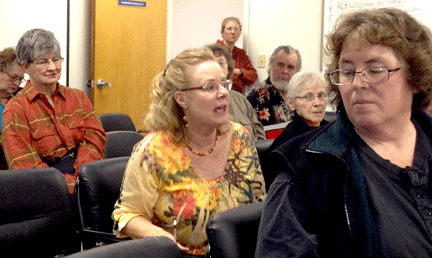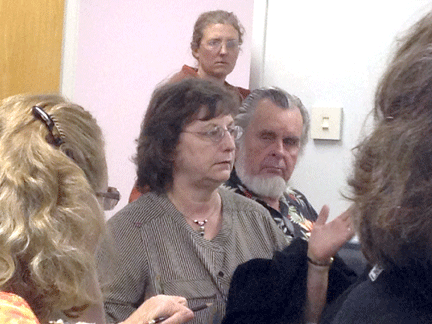Pipeline risks desribed to EQC

Members of the Kentucky Environmental Quality Commission got a detailed lesson about the dangers and shortcomings of the proposed Bluegrass Hazardous Liquids Pipeline at their meeting on November 21.
Landowners and neighbors in the possible path of the pipeline, as well as other concerned community members, provided amble information about the unnecessary and unacceptable risks associated with having high volumes of hazardous liquids running through their communities.
Those dangers are compounded by the proposed use of hundreds of miles of “repurposed” pipeline that is 50 years old along some parts of the route, operated by a company with a poor safety record, commissioners were told.
 Bob Pekny of Woodford County shattered company claims that the pipeline would be safe because it would be subject to 24-hour monitoring from 1,000 miles away.
Bob Pekny of Woodford County shattered company claims that the pipeline would be safe because it would be subject to 24-hour monitoring from 1,000 miles away.
“Pipeline monitoring only detects about one in 20 leaks,” he reported on his research. “Most are found by boots on the ground.”
In part, that’s because even the best detection equipment will miss small leaks where there are only minute drops in pressure.
“The absolute best they can detect is a leak of about 0.5 percent,” Pekny explained. At the high volumes planned for the proposed Bluegrass Pipeline, that could represent up to 4,000 gallons a day going undetected.
Such inevitable leaks present great risks to nearby residents, Dick Watkins explained. When natural gas liquids escape, a majority of the product turns to a gas that is heavier than air, is highly explosive and is an asphyxiant.
The remaining liquid portion can “enter the groundwater and can be toxic because of the presence of benzene,” Watkins added.
He also explained that repurposing old pipelines to carry natural gas liquids presents more immediate safety concerns than new pipelines. These pipelines – the Texas Gas Line in western Kentucky, and the Tennessee Gas Pipeline that enters northeastern Kentucky near Greenup and runs diagonally across much of the state – were build using outdated welding techniques and pipeline coatings no longer considered adequate.
Speakers also talked about the risks to Kentucky’s surface and ground water from pipeline construction and leaks.
Hydrogeologist and karst expert Dr. Ralph Ewers explained the proposed pipeline would cross many areas with numerous caves, groundwater conduits, sinkholes and springs.
 “The difficulty with karst conduits is that we don’t know where most of them are. We don’t know where the karst conduits lead,” he said. “We need to do tracing so we know in advance where this stuff where will wind up and who’s going to get it.”
“The difficulty with karst conduits is that we don’t know where most of them are. We don’t know where the karst conduits lead,” he said. “We need to do tracing so we know in advance where this stuff where will wind up and who’s going to get it.”
He added that he doubted the company would be willing to take such precautions.
Amy Boone showed how the company seems unconcerned by even obvious sensitive water areas. She showed a photograph of a survey stake within a few feet of a spring, and a video (see http://bit.ly/18i7lT6) where a land agent, when shown the proximity of survey stakes to a cave that feeds a pond, retracts a previous statement that the pipeline would avoid such areas.
Commissioners also were told how company agents have disrespected landowners, are trying to undermine the environmental impact study process, and have used the perceived threat of eminent domain to pressure landowners into signing easement contracts.
“This company has lost its integrity, it has lost its humanity,” said Deb Pekny. “We are no more than a blue line on a map.”
Commissioners were reminded that natural gas liquid pipelines, despite their hazardous products, are not subject to the same siting and necessity requirements that most other pipelines are.
Sister Maria Visse of the Loretto Community and Lane Boldman of the Sierra Club reminded everyone that what’s at stake is more than just the possible siting of one pipeline.
Eight recommendations for commission action were presented by the landowners. They were mostly directed at getting state and federal officials to show some concern and proactive action to protect people and the land, air and water from the risks of these hazardous liquids pipelines.
Commissioners agreed to take several steps to learn more and to invite company representatives to their January meeting.
Recent News
Kentucky’s past legislative session showed alarming trend toward government secrecy
Churchill Downs takes more than it gives. That's why the Kentucky Derby is a no-go for me
‘We must never forget.’ Kentucky town installs markers for lynching victims.
Featured Posts
TJC Rolling Out The Vote Tour – a KFTC Reflection Essay
KFTC Voter Empowerment Contractor Reflection Essay
Voting is Power
Archives
- Home
- |
- Sitemap
- |
- Get Involved
- |
- Privacy Policy
- |
- Press
- |
- About
- |
- Bill Tracker
- |
- Contact
- |
- Links
- |
- RSS


Add new comment